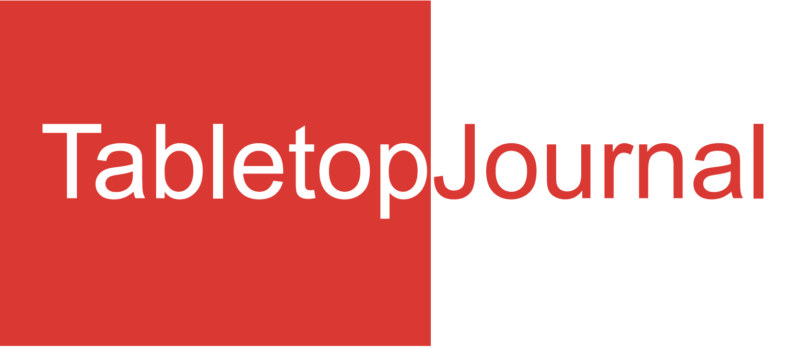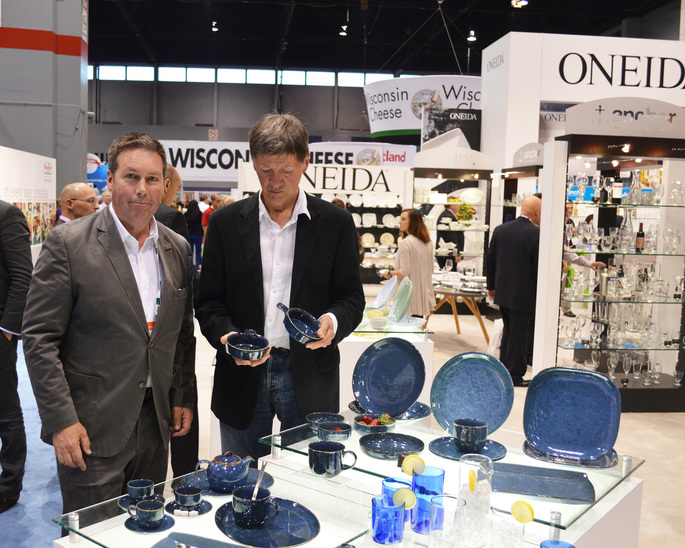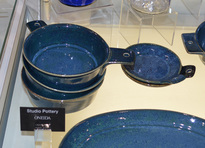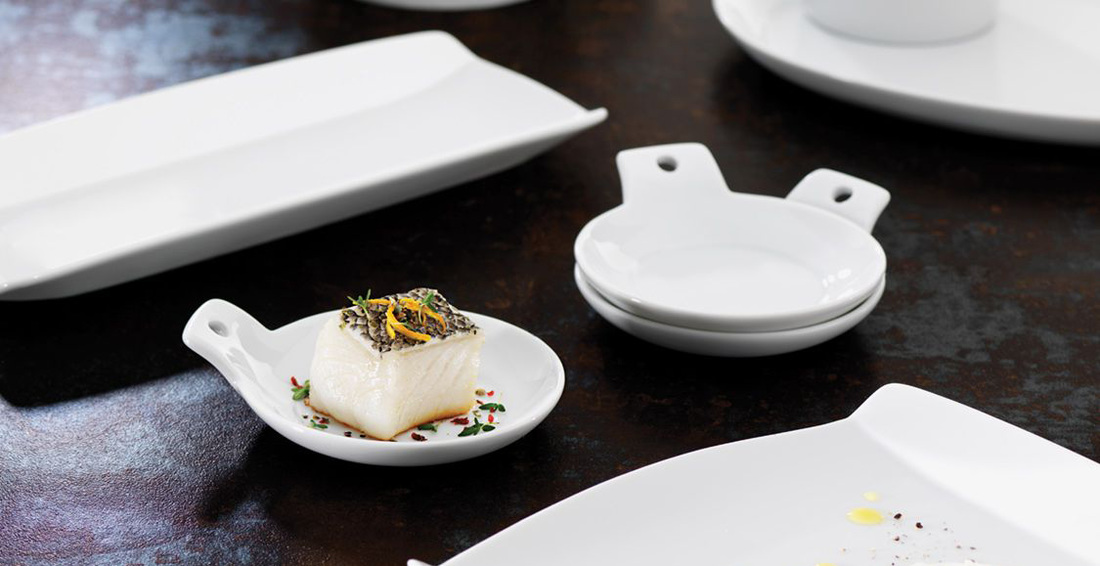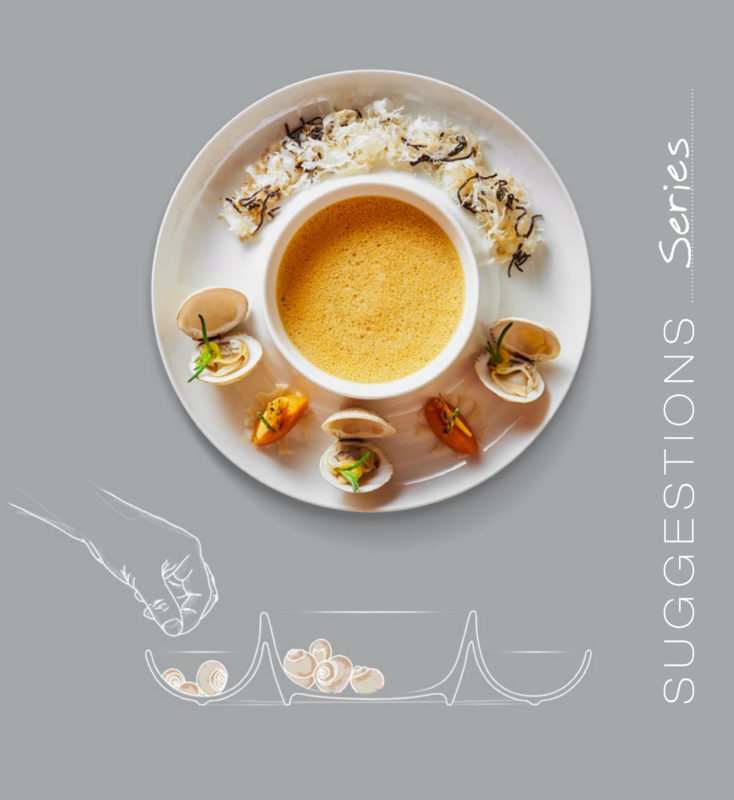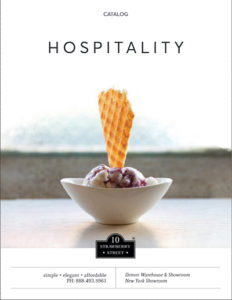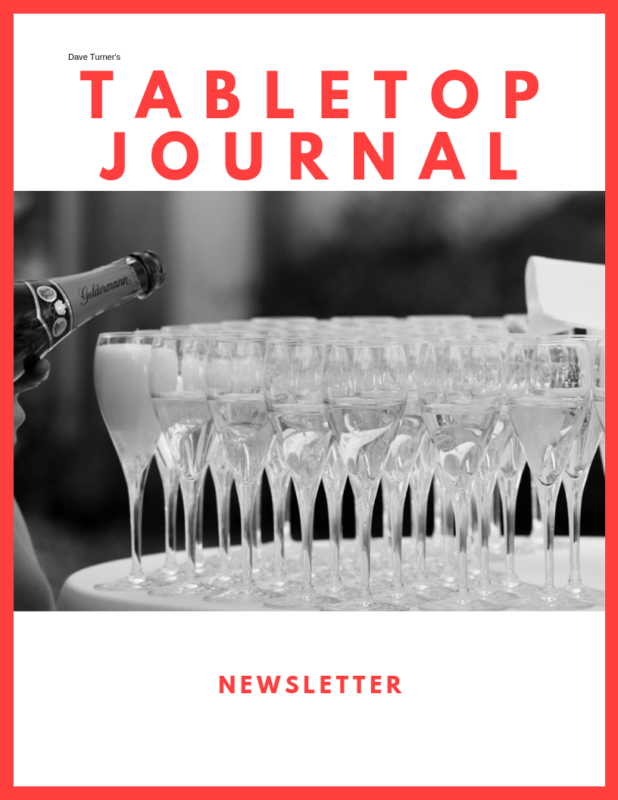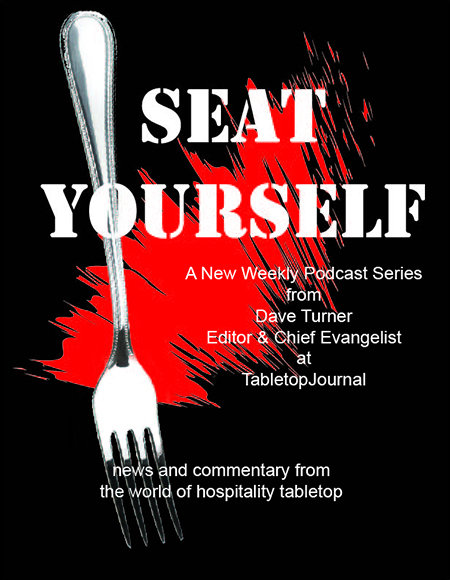Oneida Sr. VP of Design Paul Gebhardt (left) and London designer Martin Hunt (right) discussing the evolution of Oneida’s new PERIMETER collection of hospitality dinnerware. During the just completed 2015 NRA Show in Chicago, we had the opportunity to sit with the two creators of the new Oneida PERIMETER dinnerware collection, Oneida Senior Vice Pesident of Design Paul Gebhardt and dinnerware designer Martin Hunt from the famed London design house of Queensberry Hunt. It’s not often that you can learn the “inside details” of how a particular hospitality dinnerware collection evolved from concept to creation, but these two gentlemen allowed us to steal a few minutes of their time and they took us through the process and thinking behind Oneida’s newest collection PERIMETER. Here’s how it went: TabletopJournal: First question. I’m told both you gentlemen were involved in the creation of new PERIMETER? Is that true? That this was a collaborative effort?
Martin Hunt: It is! Really, we got the first brief from Paul because we did BOTTICELLI and we also designed their NEXUS range and it seemed natural, to get going on something else. And, so then we had a conversation about it really. What should we fit in now? Or, whether they wanted more of our sort of style, which is sort of, good clean modernism? The way we present things is very much a conversation with the client, rather than a big styling statement….particularly with somebody like Paul, you know, who we rely on very, very much as an experienced designer.
Paul Gebhardt: Yes, so we entered into a phase of development with Martin and his partner, David (Queensberry). And, the gestation period was quite long for this particular design. But we were at a point where we wanted a relationship with a design team that would grow. We had a couple of positions or needs in the market that we could define. One of them was this PERIMETER shape, that was on trend or a little bit ahead of the trend at the time.
And it’s important that we do involve color. So we kicked that around and Martin had some ideas that we worked on in the past, along with some ideas on where to go in the future. So that was the foundation for this design. And it’s nice that we do have color, coming out at the end of the development pipeline, as well as the unique shapes, small plates, and things like that.
The Studio Pottery version of new PERIMETER TJ: So when you started the process, you knew at some point there would be color involved?
PG: With this particular design, color was a component from the beginning. There weren’t specific colors that we were thinking about at the time. Martin was just thinking about the center well color. And he had some ideas around that kind of decoration potential.
MH: Yes, very delicate colors… in fact, one of the reasons the PERIMETER shape was designed flat so that if necessary we could flood this area with glaze. It naturally would flow flat. So, these are areas are what we could put on colors, which we have done on PERIMETER and in an all-over form. But originally they were going to be just flooded in. You can’t do that with a normal porcelain plate because they’re too uneven in the well area, because of the foot rings underneath and the slight collapsing in the kiln during production. So, with that, we determined the coupe shape that we both agreed would be nice. To have a nice wide, and absolutely flat surface, rather than a surface that was uneven. There is one more fundamental reason we chose the coupe shape rather than the rim shape. We decided that we had gotten a little bit tired of heavy hotel ware.
PG: And, well, the coupe shapes were getting hot, right? One reason for that is that table sizes weren’t getting bigger, they were getting smaller. So, the plating surface was economical. Coupe shapes are typically casual, so, with PERIMETER, if we defined the center well to have the same kind of plating surface as a rimmed plate, but a little more tailored and a little upscale perception.
That’s the initial positioning of the PERIMETER dinner plate, but along with the dinner plate, we thought we should have smaller innovative elements….that led to the small plates, as accompanying pieces. We also added some interesting ovals that are truncated at the ends, rather than completing the oval, which Martin made the point that you never really use that end of the oval, so why not just lop it off, and keep the end open.
TJ: Where there any other influencers that helped to determine the shape direction for PERIMETER?
MH: We wanted to design something that was a little bit more like fine china…like you might have in your own home. Because BOTTICELLI has been wonderful and NEXUS, which we designed, were certainly 3, 4 or 5 and half millimeters thick at the rim, we thought it was time for a change. This time we thought we’d go for a lighter, finer, delicate look. So, that’s what’s going across most pieces in the collection. But, Paul…talking about the development of the small pieces, now that’s something which evolved later in this gestation period. Lately, it has become so blindingly obvious that restaurant guests have been going for the first part of the menu, saying “Oh I’ll have two starters please.” They won’t have a main course, particularly at lunch time. And what do you get those starters served on? An 8 inch plate! And we had gotten so sick of this. It was happening in London, even in good restaurants, where we visit from time to time.
So, it had become clear that you need pieces that are so beautifully designed specifically for the starters and they can be held in an appropriate manner. Any number of the things in the PERIMETER range, like the cocktail dish, would be appropriate for smaller starter portions.
PG: Along with the restaurant scene, of course, buffets are also hot, often serving single items. You’ve been to the Las Vegas scene, you see how they’re serving. The PERIMETER items are very versatile, they’re going to be used all over the place. Its fresh, it’s new…and will work on most buffets, since buffets generally are pretty flexible.
We don’t have specific pieces for buffets since this is just coming out. But, obviously we’ll look at that going forward. We certainly think there will be opportunities to match PERIMETER pieces up with our Buffet Euro buffet units.
TJ: What else should we know about Oneida’s new PERIMETER collection?
PG: Well, I think there’s something in it for everybody. Unlike our table at home, in the food service industry today, everyone understands plating. It’s a business where the plate never comes to the table without food on it. So, the guests tend to see it that way. And I know that the sales team that we have at Oneida clearly sells that way and enhance the guest experience. In the front of the house, we look for the “wow”, first you eat with your eyes!
But, PERIMETER works in the back of the house, too. There are several things that PERIMETER has in it, that are for the back of the house too. With PERIMETER, they’ll be no metal marking because the special surface on the back. The surface has an interesting extra step with Oneida’s innovation to put this protective decal on the back. It’s there to minimize picking up stainless steel in the kitchen, so it won’t transfer it to the plate that’s it sits on top of when it’s in the stack. Because of PERIMETER’s lower profile, its stack height is much lower than that of a traditional thicker hotel and restaurant plate, meaning better storage in less space. Saving space is important.
MH: Yes, if you take away the four or five millimeters of the foot ring it makes an enormous difference in the way it stacks.
PG: So, we’ve got benefits for the back of the house operations and we’ve got things for the front of the house. But we know, first, the chef and the culinary people are obviously going to take this into the test kitchen and figure out how to plate whatever menu items they’ve got.
Whether it’s a restaurant, a ship, a hotel or a room service operation, with PERIMETER, I think there’s something for everybody here. It’s a very pleasing shape and pretty personal – and flexible – in terms of where it can go.
TJ: It sounds like a great partnership between Oneida and Queensberry Hunt? Where do you go from here?
PG: Well, immediately after this, I think we will continue to work on more color. There’s the completion of the center well color… to see whether we use that or not. There are additional over-all colors for this range. So, color is happening. Colors are hot. Culinarians are starting to think about something other than bright white porcelain to place food on, which is different from where we’ve been in recent times. New PERIMETER has unique, food friendly pieces like small round, bit-size plates for easy holding and open-ended trays. MH: Our mutual friend, Maham Anjum, who does terracotta in London, did some research work when we were coming to Lancaster to meet with Oneida, which I’ve got on my iPad. And it was all off social media, all in America, I guess you’ve seen it. Hundreds of plates and only one or two of them in all these hundreds of plates was a white plate. All the rest were various colorful ceramic materials with food on them and they were all in food service….with a lot of them were made by studio potters and they were made in America. And it was an eye opener for us as …
PG: So, we’ll continue to develop color here, but I think in terms of new shape projects with Martin and David….BOTTICELLI and NEXUS are core products for us, right, but clearly they have a life cycle. So we’ll manage that going forward, and you know design is what helps define the Oneida brand.
So, when it comes to design we always look for a design that has elements of culinary trends, elements of lifestyle trends, and elements of design trends. That kind of interaction.
So, for the culinary world, there’s a reason for small plates to exist, right? PERIMETER is good there. If, from a design perspective it fits, color right? And then from a lifestyle trend, smaller is a trend, as well.
If they all converge then it probably fits the Oneida design profile. That’s where we are with new PERIMETER.
Because, for us being in that right place includes all three elements: Culinary. Design. Lifestyle. So we like to be in that spot where when it does arrive, so we can have the right design for it.
At Oneida, we think you need to look at food, design and life style as a total.
